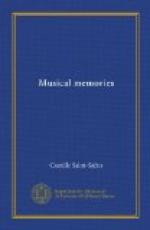The Dante symphony has not established itself in the repertoires as has the Faust symphony. It was performed for the first time in Paris at a concert I organized and managed at a time when Liszt’s works were distrusted. Along with the Dante symphony we had the Andante (Gretchen) from the Faust symphony, the symphonic poem Fest Kloenge, a charming work which is never played now, and still other works. It would be hard to imagine all the opposition I had to overcome in giving that concert. There was the hostility of the public, the ill-will of the Theatre-Italien which rented me its famous hall but which sullenly opposed a proper announcement of the concert, the insubordination of the orchestra, the demands of the singers for more pay—they imagined that Liszt would pay the expenses—and, finally, complete—and expected failure. My only object was to lay a foundation for the future, nothing more. In spite of everything I managed to get a creditable performance of the Dante symphony and I had the pleasure of hearing it for the first time.
The first part (the Inferno) is wonderfully impressive with its Francesca da Rimini interlude, in which burn all the fires of Italian passion. The second part (Purgatory and Paradise) combines the most intense and poignant charm. It contains a fugue episode of unsurpassed beauty.
Ce qu’on entend sur la montagne is, perhaps, the best of the famous symphonic poems. The author was inspired by Victor Hugo’s poetry and reproduced its spirit admirably. When will this typical work appear in the concert repertoires? When will orchestra conductors get tired of presenting the three or four Wagnerian works they repeat ad nauseum, when they can be heard at the Opera under better conditions, and Schubert’s insignificant Unfinished Symphony.
* * * * *
The Christus oratorio was given at the first concert of the festival at Heidelberg. It lasted three hours and a half and is so long that I would not dare to advise concert managers to try such an adventure. The performance was sublime. It was given in a newly constructed square hall. Cavaille-Coll, who knew acoustics, used to advise the square hall for concerts but nobody would listen to him. Three hundred chorus singers, many from a distance, were supported by an orchestra that was large, but, in my opinion, insufficient to stand up against this mass of voices. Furthermore, the orchestra was placed below the level of the stage, as in a theatre, while the voices sounded freely above. Two harps, one on the east side of the stage and one on the west, saw each other from afar,—a pleasingly decorative device, but as annoying to the ear as pleasing to the eye. The chorus and the four soloists—their task was exceedingly arduous—triumphed completely over the difficulties of this immense work and all the varied and delicate nuances were rendered to perfection.




